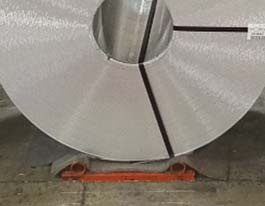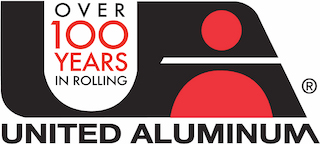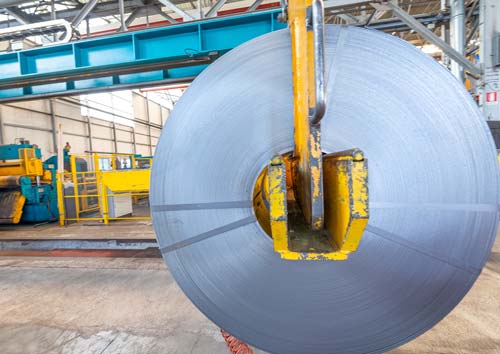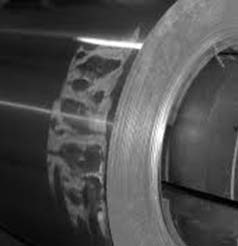Whether you’re a seasoned pro or just starting out, understanding the best practices for handling and storing coiled aluminum strip is essential for maintaining its quality and usability, while contributing to a safer work environment. In this guide, we’ll detail techniques to help you effectively manage your coiled aluminum strip inventory, from initial handling to long-term storage.
Proper Handling
When it comes to working with coiled aluminum strip, proper handling is critical. From the moment it arrives at your facility to the point of use, every handling step can impact the coil’s quality. Essentially, it all comes down to the old cliché: it must be “handled with care”. Here are specific actions and precautions you should take to minimize damage to the material:
- Inspect incoming material for any damage or wetness. If any is observed, note this on the shipper’s paperwork, and notify the supplier as quickly as possible.
- Store aluminum ONLY in a location where the humidity and temperature will not cause condensation. A heated, humidity-controlled environment is best.
- Metal that is colder than the location must be allowed to warm to ambient temperature. Follow the Aluminum Association’s Guidelines (PDF} for preventing water stain.
- Coiled strip handling may vary depending on the orientation as follows:
 For vertical coils / Eye-to-the-side- ensure they are safely banded before moving or lifting. This type of coil is typically lifted by crane with a C hook, or by forklift. Ensure your equipment limitation is not exceeded by the coil weight or size. Do not place coils directly on concrete floors, use some type of coil padding or cushion under the coil. Secure coil from rolling using chucks or braces. Stacking coils on top of each other is not recommended. Always follow all applicable safety precautions.
For vertical coils / Eye-to-the-side- ensure they are safely banded before moving or lifting. This type of coil is typically lifted by crane with a C hook, or by forklift. Ensure your equipment limitation is not exceeded by the coil weight or size. Do not place coils directly on concrete floors, use some type of coil padding or cushion under the coil. Secure coil from rolling using chucks or braces. Stacking coils on top of each other is not recommended. Always follow all applicable safety precautions.- For Eye-to-sky coils on skids, these are typically moved using forklift trucks. Again, make sure the equipment being used is capable of safely transporting the size and weight of the package. Watch your load center. Never try to lift coils packed on a damaged skid. Use caution to avoid contacting the metal with the forks as this may cause sidewall damage. Individual cuts or coils from a skid may be lifted with a sling, vacuum grab, or other equipment. Always follow all applicable safety precautions.
- Processing equipment should be inspected for cleanliness before processing aluminum. All contact surfaces and rolls should be thoroughly cleaned and inspected for damage to prevent transfer of defects onto the strip.
Proper Storage
Proper storage is key to preserving the quality of coiled aluminum strip over time. Improper storage conditions can lead to corrosion, deformation, and other forms of damage, compromising the material’s usability and performance. Here are some best practices for storing coiled aluminum strip to help optimize its lifespan and performance:
- If possible, keep your coiled strip in its original packaging until needed.
- If storing coils eye-to-side, ensure they are tightly re-banded before moving for safety and to prevent wrap-to-wrap movement that can cause scratching.

Water Stained Coil
- To minimize the possibility of waterstain, the storage location should be heated and humidity controlled. Differences in the temperature of the metal and the storage location can lead to condensation and waterstain. If the temperature of the metal drops below the dew point of the surrounding air, condensation will form. Storage of aluminum where the temperature changes, such as near outside doors, or where it is exposed to high humidity increases the possibility of damage.
Waterstain, or “white rust” occurs when moisture is trapped between the wraps of coiled strip, and without any airflow then causes a chemical reaction on the surfaces that is a form of corrosion. This waterstain corrosion can start to happen immediately when aluminum is exposed to moisture, and cannot be removed. - An industrial storage racking system can help eliminate the need to stack skidded coils directly on top of each other and reduce possibility of edge damage.
Proper handling and storage are essential aspects of managing coiled aluminum strip inventory effectively. By following the guidelines we’ve outlined here, you can minimize the risk of damage and ensure longevity and performance of your coiled aluminum. Remember to handle with care, keep the material protected, store in suitable conditions, and inspect regularly for signs of damage. With these practices in place, you can achieve optimal results with coiled aluminum strip.
Water Stained Coil Image Source: The Aluminum Association, aluminum.org.


